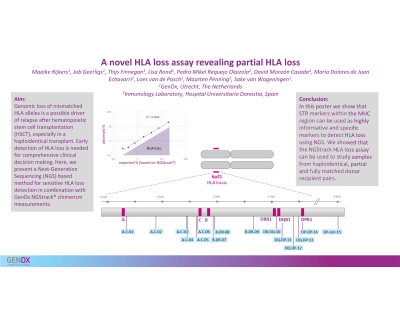Back

(P114) A novel HLA loss assay revealing partial HLA loss
Location: Platinum Ballroom


Loes van de Pasch, PhD
GenDx
Poster Presenter(s)
Aim: Genomic loss of mismatched recipient HLA alleles is a possible driver of relapse, especially in a haploidentical transplant. Early detection of HLA loss is desired for comprehensive clinical decision making. In case of traditional relapse, donor lymphocyte re-infusion or modulating immunosuppression is a treatment option. These are not valid options in the case HLA loss occurs. HLA loss can be measured by quantifying the levels of markers within the MHC region. We are developing a NGS based method using STR markers within the MHC region for increased informativity and combined it with NGStrack (GenDx) chimerism measurement.
Method: We have developed prototype assays for over 15 STRs interspersed between HLA-A and HLA-DPB1. Assays are sequenced on an Illumina MiSeq and analyzed in an experimental version of TRKengine (GenDx). The software reads FastQ files, extracts information on STR counts, and visualizes STR lengths, from which marker percentages are established. These are used to determine informative markers pre-transfer (samples need to be genotyped once) and detection of HLA-loss post-transfer.
Results: In a retrospective study, post-HSCT samples from a fully matched (12/12) and a partially matched (HLA-A, HLA-DPB1 mismatch) transplantation were analyzed. Interestingly, in the post-sample from the fully matched transplantation we still discovered multiple informative markers. So, although donor and recipient are matched for HLA genes, a part of the MHC region is not matched and can be analyzed using these markers. The post-HSCT fully matched sample did not show loss of any of the informative markers.
In the sample from the partially matched transplantation multiple informative markers were discovered within the MHC region. Loss of recipient specific STR alleles indicated partial HLA loss in this post-HSCT sample. Notably, only markers surrounding the mismatched HLA genes (HLA-A and DPB1) indicated HLA loss and others did not. The retrospective revision of this patient showed that upon relapse the patient was treated with DLI and showed no response.
Conclusion: STR markers within the MHC region can be used as highly informative and specific markers to detect HLA loss using NGS. Here we show that the 15 marker prototype assay can be used to study samples from fully HLA matched transplantations. Moreover, this assay can be used to discover partial HLA loss.
Method: We have developed prototype assays for over 15 STRs interspersed between HLA-A and HLA-DPB1. Assays are sequenced on an Illumina MiSeq and analyzed in an experimental version of TRKengine (GenDx). The software reads FastQ files, extracts information on STR counts, and visualizes STR lengths, from which marker percentages are established. These are used to determine informative markers pre-transfer (samples need to be genotyped once) and detection of HLA-loss post-transfer.
Results: In a retrospective study, post-HSCT samples from a fully matched (12/12) and a partially matched (HLA-A, HLA-DPB1 mismatch) transplantation were analyzed. Interestingly, in the post-sample from the fully matched transplantation we still discovered multiple informative markers. So, although donor and recipient are matched for HLA genes, a part of the MHC region is not matched and can be analyzed using these markers. The post-HSCT fully matched sample did not show loss of any of the informative markers.
In the sample from the partially matched transplantation multiple informative markers were discovered within the MHC region. Loss of recipient specific STR alleles indicated partial HLA loss in this post-HSCT sample. Notably, only markers surrounding the mismatched HLA genes (HLA-A and DPB1) indicated HLA loss and others did not. The retrospective revision of this patient showed that upon relapse the patient was treated with DLI and showed no response.
Conclusion: STR markers within the MHC region can be used as highly informative and specific markers to detect HLA loss using NGS. Here we show that the 15 marker prototype assay can be used to study samples from fully HLA matched transplantations. Moreover, this assay can be used to discover partial HLA loss.
